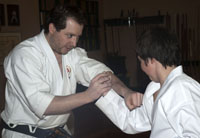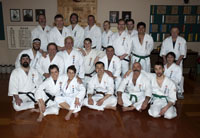


OVERVIEW OF UECHI-RYU HISTORY
Uechi-Ryu (pronounced Way Chee Roo) Karate-Do is derived from a form of Chinese temple fighting. Although the original name of this Chinese system is not known, Uechi-Ryu scholars are constantly striving to uncover the history of their art. Whatever the formal name, however, the Chinese word
Pangai-noon (pronounced PWANG-GAY-NOON) has been used to describe the original form, and has thus been accepted as the proper name. Pangai-noon was taught in the Shoalin Temple in Southern China, and is derived from the interwoven movements of the tiger, crane and dragon. It is a specialized method of self defence that concentrates on the use of the single‑knuckle punch, spear‑hand strike, pointed-toe kick and circular block.
Grandmaster Kanbun Uechi, the founder of Uechi-Ryu Karate-Do, is responsible for lifting the veil of secrecy, bringing this art out of China and into Okinawa and Japan. He was born on May 5, 1877 in lzumi, a small village in northern Okinawa. At the age of 20, in order to avoid serving in the Japanese military, which at that time occupied Okinawa, Kanbun fled to China. There, in Fukien province, he studied the art of Pangai‑noon. His teacher was Shushiwa, a Buddhist priest who had received his training in the Shoalin Temple. Master Uechi studied in Fukien for ten years and became a master of Pangai-noon. At the end of his training, Master Uechi opened a school in Nanchon, a city in Fukien Province, where he taught for three years. During this time, one of his students became involved in a dispute and called upon his training to kill another person. Disheartened by this event, Master Uechi vowed never to teach again, closed his school and returned to his homeland. The year was 1910. Master Uechi has the distinction of being the only Okinawan ever to have been accepted in China as a teacher.
Returning to Okinawa, he married, and on June 26, 1911 his son Kanei was born. He still refused to teach his art and only once during the ensuing years reluctantly demonstrated his Kata (formal set of movements).
In 1924 the Uechi family moved to Wakayama Prefecture near Osaka, Japan. In 1927 Master Uechi began teaching his son Kanei the art of Pangai‑noon. Around this time, friends persuaded him to resume teaching publicly.
In April 1942, Master Uechi's son Kanei, now a master in his own right, returned to Okinawa from Japan. Master Kanbun Uechi continued to teach in Wakayama Prefecture until 1947, and at the age of 71, died November 25, 1948 on lejima, an island off the coast of Okinawa. His body was returned to Nago, Okinawa for burial. During this year, his students renamed the style Uechi‑Ryu (Ryu is Japanese for "style") in his honour.
His son, Master Kanei Uechi, opened his dojo (training hall) in Futenma, Okinawa in April of 1949 and taught there until his death in February of 1991.
Sensei Dunnigan’s Uechi-Ryu Lineage
- Shushiwa; teacher of Kanbun Uechi; taught in Fuchow city, Fukien Province, Southern China circa 1890.
- Kanbun Uechi (pronounced Calm-boon Way-chee); 9th degree Black Belt (Kyudan), Hanshi; and founder of Uechi-Ryu Karate-Do; student of Shushiwa; born in Izumi, Okinawa on May 5, 1877, died November 25,1948.
- Kanei Uechi; 10th degree Black Belt (Judan), Hanshi-sei; student of his father, Kanbun Uechi ; second master of Uechi-Ryu; born June 26, 1926, 1911, died Feb. 24, 1991.
- George Mattson; 9th degree Black Belt, Hanshi; student of Ryuko Tomoyose; teaches in Boston, Mass.
- Jim Maloney; 8th Degree Black Belt (Hachidan), Kyoshi; student of George Mattson, taught in Halifax, Nova Scotia.
- Tsutomu Nakahodo; 10th degree Black Belt, Hanshi, student of Seiyu Shinjo and Kanei Uechi, presently teaches in Naha, Okinawa. Visited the Edmonton Dojo in July 2002.
- Neil Dunnigan, 7th degree Black Belt (Nanadan); initally a student of Jim Maloney; teaches in Edmonton, Alberta. He has trained with in Okinawa with senior Okinawan masters, including Master Kanei Uechi. Since 1990, he has been a student of Sensei Tsutomu Nakahodo.
